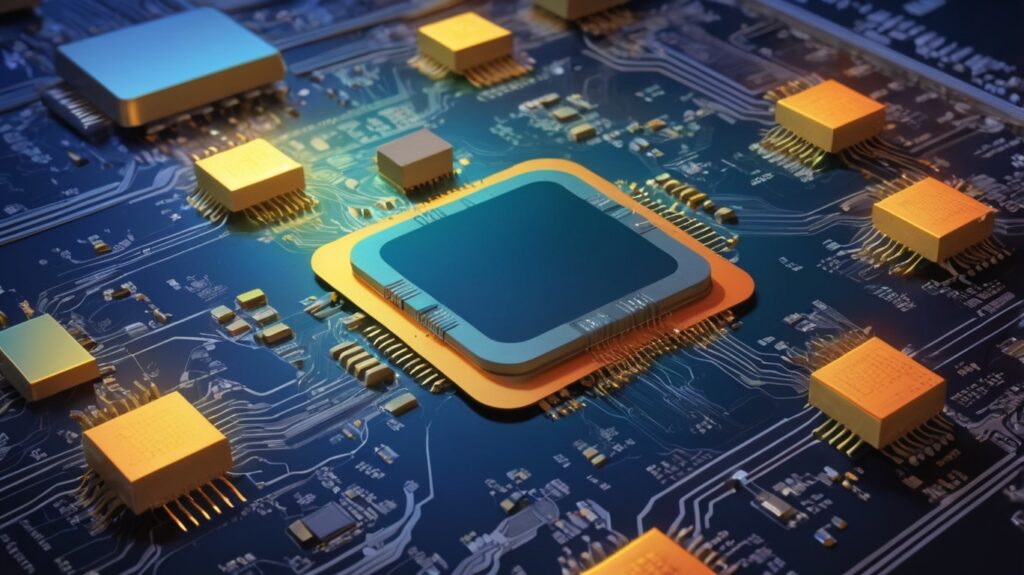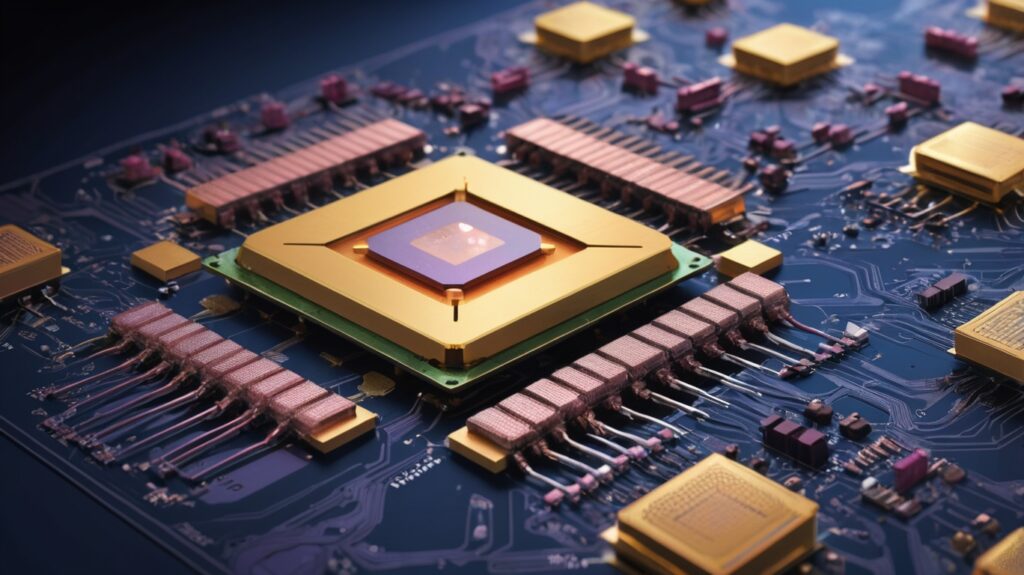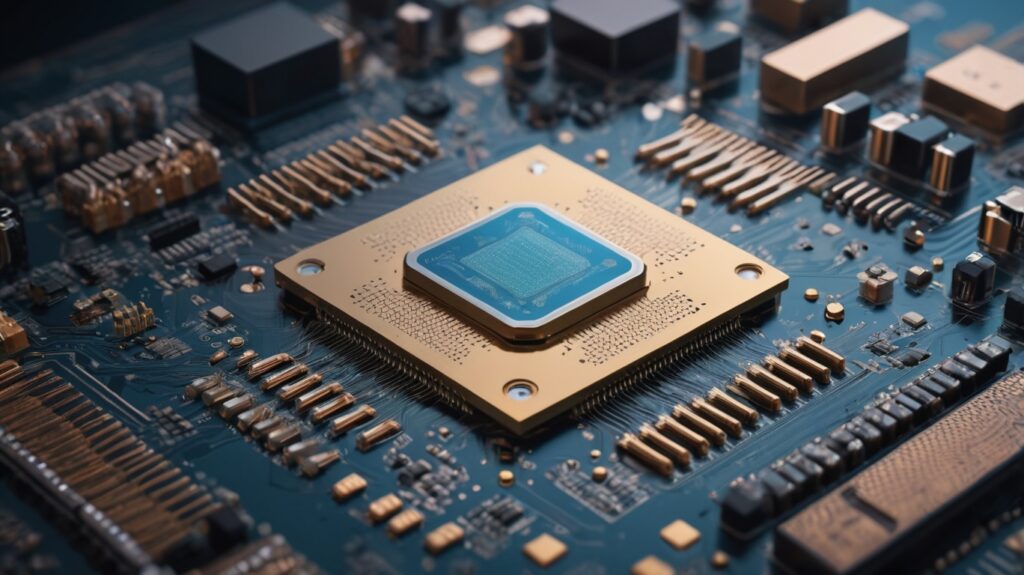Semiconductors are the unsung heroes of modern technology. These tiny materials, with the unique ability to control electrical current, have paved the way for everything from smartphones to supercomputers. Their importance cannot be overstated—they are the backbone of the digital age, driving innovation across industries. But what are semiconductors exactly, and why are they so pivotal?
What Are Semiconductors?
At their core, semiconductors are materials that have a conductivity level between conductors (like copper) and insulators (like rubber). This intermediate conductivity allows them to control the flow of electrical current in a precise manner, making them indispensable in electronic devices. Typically, semiconductors are made from silicon, though materials like germanium and gallium arsenide are also used.
Semiconductors are a special class of materials that can behave as both conductors and insulators depending on external conditions, such as the presence of an electric field, heat, or light. This makes them incredibly versatile and essential for a wide range of applications.

The term “semiconductor” can often seem highly technical, but understanding the basics is simpler than it sounds. These materials are at the heart of microchips, diodes, transistors, and other components that power everything from home appliances to space exploration systems.
How Semiconductors Work
Understanding how semiconductors work requires a look into the physics of materials. Electrons, which are negatively charged particles, flow through conductors such as metals easily. In insulators, electrons are tightly bound to their atoms and cannot flow freely. Semiconductors occupy the middle ground.
In a semiconductor, the behavior of electrons can be controlled in a highly specific way. The addition of impurities—a process called doping—modifies the electrical properties of semiconductors, making them more conductive or less conductive as needed. By carefully controlling this process, engineers can create devices that control electrical current flow with great precision.
For instance, a semiconductor in a transistor can act as a switch, turning on or off the flow of current. This is the fundamental principle behind how computers and many other electronic devices function. Semiconductors enable the rapid switching of current that forms the basis for binary logic, the foundation of digital technology.

Types of Semiconductors
Semiconductors can be classified in various ways, including by material, electrical properties, and structure. Below are the most common types.
Intrinsic Semiconductors
Intrinsic semiconductors are pure materials without any significant doping. Silicon and germanium are the most widely known intrinsic semiconductors. These materials in their natural form have very few free electrons, making them relatively poor conductors. However, by applying energy in the form of heat or light, electrons can be excited to higher energy levels, increasing conductivity.
Extrinsic Semiconductors
Extrinsic semiconductors are materials that have been intentionally doped with impurities to improve their electrical conductivity. There are two main types of extrinsic semiconductors:
- n-type Semiconductors: In these, materials are doped with elements that provide extra electrons, increasing conductivity.
- p-type Semiconductors: These are doped with materials that create “holes” or spaces where electrons can move, thus enabling current flow.
Compound Semiconductors

While silicon dominates the semiconductor industry, other materials are used for specific applications. Compound semiconductors, such as gallium arsenide, are used in high-frequency applications like radiofrequency (RF) amplifiers and LEDs. These materials often offer superior performance in specific situations, such as high-speed or optoelectronic applications.
Importance of Semiconductors in Modern Technology
Without semiconductors, the modern world as we know it would grind to a halt. The unique ability of these materials to control current flow is the foundation of almost every electronic device in use today. From personal electronics like smartphones and laptops to industrial machines and defense systems, semiconductors are omnipresent.
Semiconductors in Consumer Electronics
Think about your smartphone for a second. Every function—whether it’s processing a call, running an app, or displaying graphics—relies on billions of transistors made from semiconductors. Without semiconductors, none of this would be possible. Similarly, laptops, tablets, and other personal devices rely on semiconductors to execute multiple tasks at once, store data, and connect to the internet.
Semiconductors in Industrial and Automotive Applications
The rise of electric vehicles (EVs) has brought semiconductors to the forefront in the automotive industry. Semiconductors in these vehicles control everything from battery management systems to advanced driver assistance systems (ADAS) that enable autonomous driving features. In the industrial sector, semiconductors are vital for automation, machine learning, and robotics, pushing the boundaries of what machines can do.
The Semiconductor Supply Chain Crisis

The global importance of semiconductors became glaringly obvious during the supply chain crisis that began in 2020. With the sudden surge in demand for electronics during the pandemic and disruptions in the global supply chain, a shortage of semiconductors ensued. This crisis highlighted the critical role these materials play in the global economy. From automotive manufacturing delays to the inability to produce new gaming consoles, industries across the board felt the effects of this semiconductor shortage.
Future Trends in Semiconductors
The semiconductor industry is constantly evolving, with new innovations emerging to meet the demands of the modern world. Here are a few trends to keep an eye on:
Miniaturization and Moore’s Law
For decades, the semiconductor industry followed Moore’s Law, which predicted that the number of transistors on a chip would double approximately every two years. This trend has allowed for the creation of smaller, more powerful, and more energy-efficient devices. While some experts believe that Moore’s Law is reaching its limits due to physical constraints, new technologies like quantum computing and advanced packaging methods are keeping the industry on track.
Semiconductors in Artificial Intelligence (AI)

AI applications are driving demand for specialized semiconductors known as AI accelerators. These chips are designed to handle the massive parallel processing required for machine learning tasks. Companies like NVIDIA and Intel are at the forefront of this innovation, creating semiconductors that can process vast amounts of data at lightning speed, enabling AI systems to learn and improve more efficiently.
5G and the Internet of Things (IoT)
The rollout of 5G networks is another major factor driving semiconductor innovation. 5G requires semiconductors that can handle high-speed data transmission, low latency, and high bandwidth. In tandem with the rise of IoT, where devices from smart refrigerators to industrial sensors are all interconnected, the demand for powerful and energy-efficient semiconductors is skyrocketing.
Sustainable Semiconductors
As the world moves towards a greener future, the semiconductor industry is also embracing sustainability. Researchers are exploring new materials and manufacturing techniques that reduce the environmental impact of semiconductor production. Companies are also focusing on creating semiconductors that use less energy, which is crucial for reducing the carbon footprint of data centers and other energy-intensive applications.
Frequently Asked Questions about Semiconductors
What are semiconductors made of?
Most semiconductors are made from silicon, though other materials like germanium and gallium arsenide are also used in specific applications. Silicon is abundant, has excellent electrical properties, and is relatively easy to manufacture, making it the material of choice for most semiconductors.
How do semiconductors differ from conductors and insulators?
Semiconductors have electrical conductivity that falls between conductors and insulators. Conductors allow free flow of electricity, while insulators resist it. Semiconductors can be manipulated to conduct electricity under certain conditions, giving them unique versatility in electronic applications.
Why is doping important in semiconductors?
Doping is the process of adding impurities to a semiconductor to change its electrical properties. By adding small amounts of specific materials, engineers can control whether a semiconductor has more free electrons (n-type) or more holes (p-type), which is essential for creating devices like transistors and diodes.
What is the significance of Moore’s Law in the semiconductor industry?
Moore’s Law refers to the observation that the number of transistors on a semiconductor chip doubles approximately every two years, leading to continuous improvements in computing power, efficiency, and miniaturization. Although some experts argue that Moore’s Law is slowing down, it has been a key driver of technological progress for decades.
How are semiconductors used in smartphones?
Semiconductors in smartphones are responsible for processing data, managing power, enabling connectivity (Wi-Fi, 4G, 5G), and controlling display graphics. Without semiconductors, the computational power needed for tasks like streaming video, running apps, or even making a call would be impossible.
What is the future of semiconductors in the automotive industry?
As electric vehicles (EVs) and autonomous driving technologies evolve, semiconductors will play a crucial role in managing power, safety systems, and communication between various vehicle components. The shift towards more advanced driver assistance systems (ADAS) and electric powertrains is expected to increase the demand for more sophisticated and powerful semiconductors.
Conclusion
Semiconductors are the silent force behind the technological advancements that have transformed the world. From the devices in our pockets to the cars we drive, semiconductors power the digital age, enabling innovations that continue to shape the future. Their ability to balance conductivity and insulation, combined with ongoing advancements in semiconductor technology, ensures they will remain at the heart of modern technology for years to come.
